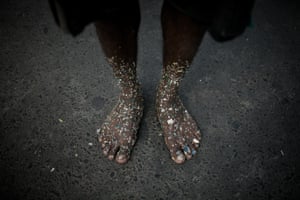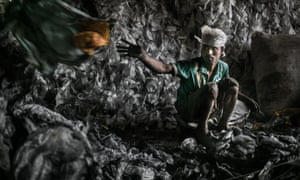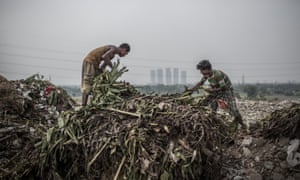From Kartik Dhara’s home, the trucks at the top of the garbage mountain look like the toys he sees city children playing with on his rounds of Kolkata. A garbage truck driver in the eastern Indian city, Dhara can’t afford to buy toys for his own children, but he often finds discarded ones where he unloads rubbish every day. “You can find everything there,” he says.
“There are dead babies, there are truckloads of smuggled chocolates or medicines that the excise department finds. I’ve even found money and gold – a lot of gold. What do I do with it? I keep it in my house. When I’m in a time of need, when there’s a big difficulty in my life, I’ll sell it and I’ll use the money.”
Dhara is one of around 30,000 people who live on and around Kolkata’s landfill site at Dhapa. Garbage collectors like Dhara clean up after the city’s 4.5 million people, and dump around four thousand metric tonnes of waste at Dhapa every day. A garbage processing industry has since sprung up on the site. In the slums at the base of the mountains of rubbish, hundreds of people make a living as ragpickers or scrap dealers, by sorting the waste and recycling. In a cremation centre on site, unidentified dead bodies – most of them corpses of hawkers or street dwellers – are burned.
Living and working on the landfill comes with serious health hazards that successive state and central governments continue to ignore. Inextinguishable fires burn all day and night, which pollute the air. They are so ubiquitous that the workers no longer complain about the fumes, and municipal authorities don’t bother to put them out.
Sovan Chatterjee, the mayor of Kolkata, says: “Of course there are fires. There are so many waste materials there; they are going to be bad for the environment.”
Dhara sees the fires every day when he’s driving his truck up to the landfill site. “The fires come on their own, from the garbage itself because of biogas,” he says, referring to gasses produced as a result of fermentation of organic waste. “They burn all day and all night, every day of the year.”
Facebook Twitter Pinterest
A dump worker’s feet covered with plastic pieces. Photograph: NurPhoto/Getty Images “You can’t go there,” he says. “Even our huge government trucks, even they fall and turn over sometimes. Especially now, in the monsoon, the garbage is wet and so the ground can fall beneath your feet anytime. Many trucks have been overturned on the mountain. People have died there.”
“It’s difficult to breathe sometimes,” says Durga Mundun, who lives on top of the landfill. “We get ill a lot. There’s a lot of pollution and it smells very bad. Even though we live here and we’re used to it, it bothers us a lot. People get sick, they get diarrhoea, they get tuberculosis.”
He adds: “Most people die by the age of 50. Sometimes they live till 60 and then they go up to God. I’m already 30, I’ll probably die soon too.”
The landfill site at Dhapa was set up when Kolkata, then Calcutta, was the colonial capital of the British Raj in India. A garbage train used to run along the main roads of the city collecting waste from all the big residential buildings and offices of the British administration. Since then, Kolkata’s population has grown, and so has the amount of waste it produces. The landfill has grown into an entire landscape of garbage, which stretches for miles on the eastern fringes of the city. Kolkata municipal council has tried to find a new dumping site in the city, with hopes to reclaim what could become prime real estate at Dhapa, but their proposals have been rejected by civic bodies because of objections from local residents.
India’s 429 million urban citizens produce a whopping 62m tonnes of garbage every day. Prime minister Narendra Modi has launched a mass cleanliness drive called the Swachh Bharat campaign urging Indians to stop spitting and defecating on streets, to stop littering, and keep their local communities clean.
In Kolkata, part of the state of West Bengal, chief minister Mamata Banerjee has launched a similar drive to clean up the city, installing 10,000 fibreglass bins and new garbage compactors to stop rubbish overflowing onto streets. As a result, Kolkata, like all of India’s major metropolises, has become ostensibly cleaner; but politicians are still struggling to address the nub of the problem: mountains of untreated waste are still dumped into vast landfills, causing environmental degradation, and health problems for workers.
In one of the straw huts in the slum, Suhas Sau is bunching up discarded plastic bags and pushing them into a machine he made from old engines, bathtubs, and metal tubes. “The bags go in from here,” he ushers towards a hole at one end of the cylindrical machine. “It’s very hot inside, so they get melted, and they come out like this,” he says, picking up a sticky black nugget that the machine spits out. “Then we cut it, and we use it to make pipes.”
Sau set up his plastic recycling factory two and half years ago after a fight with his wife. “She threw me out of the house,” he says. “I never went back; I live here alone. But I have no problems, I am happy here. For me, this isn’t just a job, it’s a way of life. This is the place where all of society’s rejects end up, the people that nobody wants. This is our world.”
With acres of cheap, unbuilt land so close to the city, Kolkata’s poorest people end up here hoping to make a living. Wages are low, and living conditions are cramped and unhygienic. Most people live and work in the same room.
Jasmine Begum sorts plastics in a straw hut in the slum. “When I started working here 10 years ago, I used to get 50 rupees (60p) a day, now I get 120. I sleep right here,” she says, tapping on a wooden table in the room where she sorts through rubbish. “I’m a poor person, what do I do?”
Begum came to Dhapa after both her parents died. “I was young; I had nowhere else to go.” She and other women in the slum try not to have children, because they know they won’t be able to afford the costs of childcare. “We don’t have money to eat, how will we educate our children?”
At Dhapa thousands of plots of land are farmed for vegetables, the swamps have become fish farms and in the huts, women fry puchkas, a popular local street food. Though no one has ever measured how much of Kolkata’s food comes from the landfill site, it is an open secret that the city’s markets are stocked with produce from Dhapa. “I grow spinach and cauliflower here,” says Raju Yadav, a farmer who lives near the landfill site. “The land is cheap and the fertiliser is free. I came here because there’s nowhere else to go.”
Urban development projects from Modi and Banerjee may have improved the city, but critics say they have done little to improve the lives of the people who feed and clean up after its residents. “Go and look at New Town,” says Yadav. “Its like New York. Of course I support the government. They’ve made our Kolkata look like London. So what if they haven’t done anything for us? They can’t work for particular people; they have to work for the whole city, for all its residents.”
Chatterjee, who oversees the Kolkata Municipal Corporation, says his government does not have the funds to manage the landfill site at Dhapa. “Being mayor, I want to see the landfill site but where do I get the money? They should pay to shift the site. Now we have become helpless, we can’t help the people living there for more the 30 years. There are at least 20-30,000 houses on there and we can’t do anything. We’re helpless.”
He says that food grown on the wasteland is safe for consumption. “Kolkata’s food on Dhapa land those have not caused any problems. It is checked by the environment minister, they’ve given me data to prove it.”
Chatterjee argues that politicians who signed the Ramsar convention to conserve international wetlands did not realise the scale of the garbage problem at Dhapa. His efforts to shift the dump further away from the city have failed because the new site chosen was protected by the Ramsar treaty. “At the time of signing the convention, Kolkata municipal council was not consulted. We are the owners of 300-400 acres of wetland.
“It is the problem of the central government. When they are going to sign a treaty, they have to realise [the] actual practical position of the land, but they didn’t consider this is in 1999. They are giving the directions to maintain the wetland site, but the convention did not give proper compensation to maintain the land.”
For Dhara, the government’s failure to act to improve the lives of Dhapa’s residents is unsurprising. “We are poor people. Nobody helps poor people. We work so we can survive, and we will keep working.”
Follow Guardian Cities on Twitter and Facebook and join the discussion




